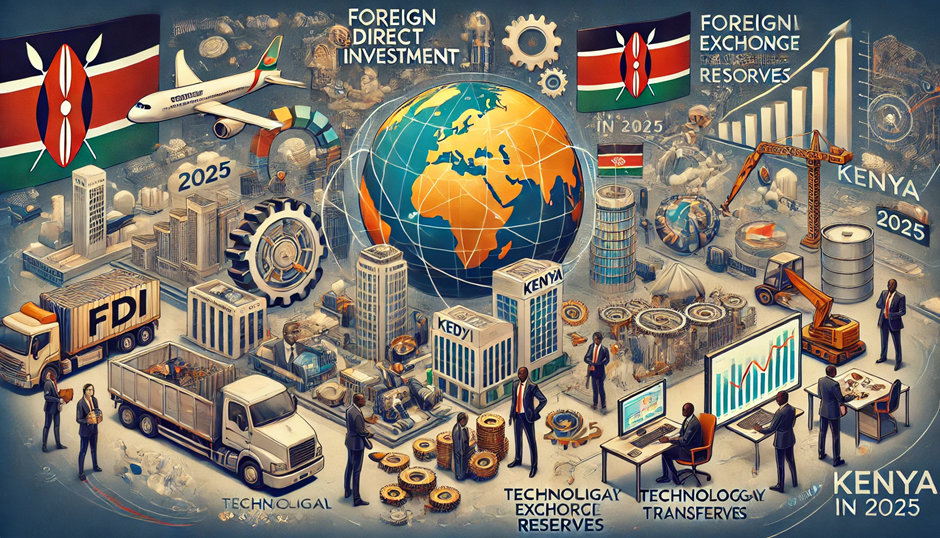
The Role of Blockchain in Kenya’s Financial Sector: A 2025 Perspective
Introduction

Blockchain technology has emerged as a game-changer in Kenya’s financial sector, offering innovative solutions to longstanding challenges in banking, payments, and financial inclusion. In 2025, Kenya is witnessing a surge in blockchain adoption, driven by its potential to enhance security, transparency, and efficiency in financial transactions.
This blog explores how blockchain is transforming Kenya’s financial landscape, key areas of application, the benefits it brings, the challenges it faces, and strategies for maximizing its impact.
Blockchain Adoption in Kenya’s Financial Sector

Government Regulation and Support
The Kenyan government and the Central Bank of Kenya (CBK) have taken significant steps toward regulating blockchain technology. In 2025, clear legal frameworks are in place to govern blockchain applications, providing a structured environment for businesses and financial institutions to innovate.
Private Sector and Fintech Integration
Kenya’s fintech sector, known for digital payment solutions like M-Pesa, is leveraging blockchain to offer decentralized and secure financial services. Leading banks, insurance firms, and startups are adopting blockchain to streamline operations and enhance trust in transactions.
Cryptocurrency and Digital Assets
Despite initial regulatory skepticism, cryptocurrencies are becoming more accepted in Kenya. Many businesses now allow payments in digital assets, and crypto-based remittances are reducing the cost of international money transfers.
Key Applications of Blockchain in Kenya’s Financial Sector

1. Secure and Efficient Digital Payments
Blockchain-powered digital payments are minimizing transaction costs and eliminating the need for intermediaries. Peer-to-peer (P2P) transactions on blockchain networks are providing Kenyans with faster and more secure payment options.
2. Financial Inclusion and Digital Identity
Blockchain-based identity verification systems enable the unbanked population to access financial services without traditional banking infrastructure. Digital identity solutions built on blockchain allow individuals to prove their identity and build credit histories.
3. Smart Contracts for Lending and Insurance
Smart contracts are automating financial agreements, ensuring transparency in loan issuance and insurance claims. Kenyan banks and microfinance institutions are using blockchain to enhance lending efficiency, reduce fraud, and simplify contract enforcement.
4. Cross-Border Trade and Remittances
Kenya is a regional trade hub, and blockchain technology is streamlining cross-border transactions by reducing costs and improving transaction speed. Blockchain-based remittances are offering a low-cost alternative for Kenyans receiving money from abroad.
5. Fraud Prevention and Transparency
Financial fraud and corruption have been persistent challenges in Kenya’s banking sector. Blockchain’s immutability ensures that transactions are transparent and cannot be altered, reducing fraudulent activities and increasing trust in financial systems.
Opportunities for Blockchain Growth in 2025

1. Expansion of Digital Banking
As Kenya moves toward a cashless economy, blockchain will play a vital role in securing digital banking transactions, enabling real-time settlements, and reducing operational risks.
2. Tokenization of Assets
Blockchain allows the digitization of assets such as land, stocks, and commodities, making ownership transfers more efficient and transparent. Kenya’s real estate and stock markets are beginning to explore asset tokenization.
3. Blockchain-Based Credit Scoring
Traditional credit assessment models often exclude large sections of Kenya’s informal sector. Blockchain-based credit scoring systems analyze decentralized financial data to provide fairer and more accessible credit opportunities.
Challenges Facing Blockchain Adoption in Kenya
1. Regulatory Uncertainty
While Kenya has made progress in blockchain regulation, gaps still exist. Concerns over cryptocurrency use, compliance, and potential misuse pose regulatory hurdles.
2. Cybersecurity Risks
Despite its security advantages, blockchain is not immune to hacking and scams. Fraudulent schemes and vulnerabilities in smart contracts pose risks to financial institutions and users.
3. Infrastructure and Internet Connectivity
For blockchain to reach its full potential, robust internet access and digital infrastructure are required. Rural areas in Kenya still face connectivity challenges, limiting widespread adoption.
4. Public Awareness and Adoption
Many Kenyans are still unfamiliar with blockchain technology. Educational initiatives and awareness campaigns are necessary to encourage trust and usage among businesses and individuals.
Strategies for Strengthening Blockchain Adoption in Kenya
1. Developing Clear Regulatory Frameworks
The government must continue refining blockchain regulations to provide clarity and confidence for investors and businesses. Licensing frameworks and legal structures should support blockchain innovation while preventing misuse.
2. Encouraging Public-Private Partnerships
Collaboration between the government, financial institutions, and technology startups will accelerate blockchain adoption. Investment in research and pilot projects will help identify the most effective applications.
3. Enhancing Cybersecurity Measures
Developing robust security protocols, conducting regular audits, and implementing blockchain governance structures will mitigate cybersecurity risks.
4. Promoting Blockchain Education and Awareness
Training programs and awareness campaigns can help demystify blockchain and encourage its adoption. Universities, tech hubs, and financial institutions should integrate blockchain education into their curriculums.
Conclusion
Blockchain technology is reshaping Kenya’s financial sector in 2025, offering secure, efficient, and transparent financial solutions. From digital payments to financial inclusion and fraud prevention, blockchain is driving innovation and economic growth. However, challenges such as regulatory uncertainty, cybersecurity risks, and public awareness must be addressed to maximize its potential. By implementing strategic policies and fostering collaboration, Kenya can position itself as a leader in blockchain-driven financial services in Africa.
References
- Central Bank of Kenya – www.centralbank.go.ke
- Kenya Blockchain Association – www.blockchainassociation.co.ke
- World Bank – Financial Inclusion Reports – www.worldbank.org
- International Monetary Fund – Digital Finance in Africa – www.imf.org
- Forbes Africa – Blockchain Trends in Kenya – www.forbesafrica.com








